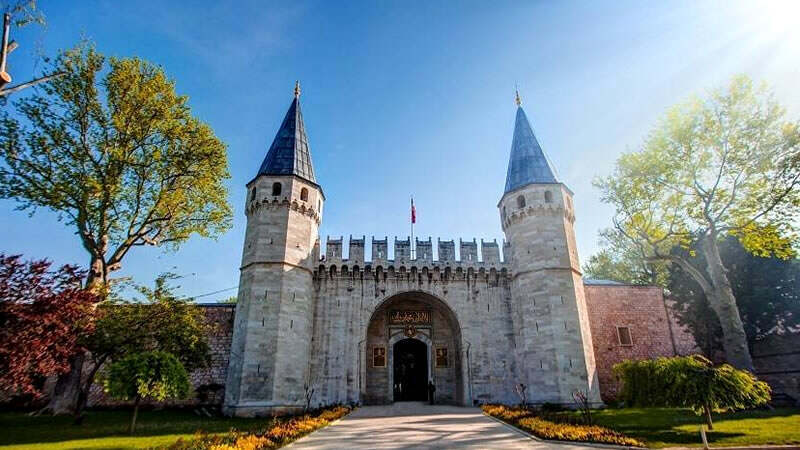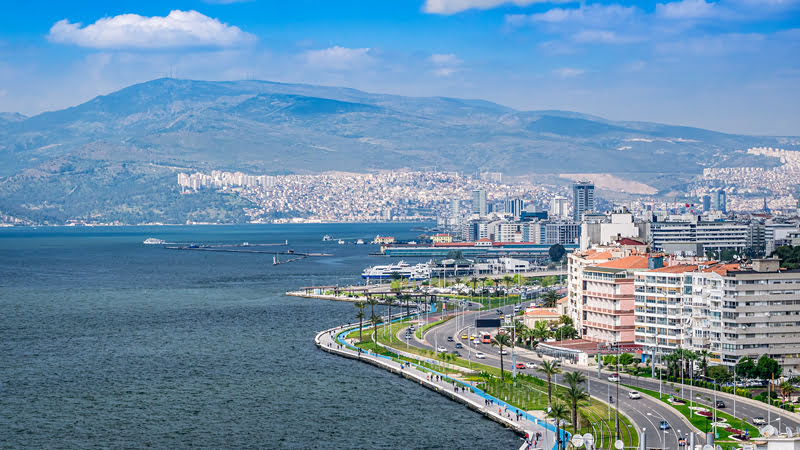Istanbul's Most Famous Palaces - A Journey Through History and Culture

Istanbul, a city that has been a crossroads of civilizations for centuries, stands out with its historical and cultural heritage, attracting worldwide attention. The city’s palaces and mansions serve as time capsules, showcasing the grandeur of the Ottoman Empire and the foundations of modern Türkiye. These structures, scattered across Istanbul, are not just architectural marvels but also cultural landmarks that draw tourists with their historical significance. The Dolmabahce, Yildiz, Beylerbeyi, and Ciragan Palaces, located throughout the city, take visitors on a historical journey while offering serene moments with the stunning views of the Bosphorus. Visitors can witness significant historical periods and events through these structures, and with Istanbul car rental services, exploring these historical routes becomes a convenient and enjoyable experience.
Topkapi Palace is one of Istanbul's most renowned historical landmarks and served as the administrative center of the Ottoman Empire for 400 years. Built by Sultan Mehmed II (Fatih Sultan Mehmet) after the conquest of Constantinople, the palace is now one of Türkiye’s most visited museums. Within its walls are significant sections such as the harem where Ottoman sultans lived, administrative offices, and palace kitchens.
Throughout its history, Topkapi Palace witnessed numerous significant events. It was home to many Ottoman sultans, from Fatih Sultan Mehmet to Sultan Abdulmecid, and the empire's destiny was shaped here. One of the palace’s most notable sections is the Harem, where sultans lived with their families and the palace community’s daily life unfolded. The rooms in the Harem are adorned with the aesthetic of the era, reflecting the intricacies of Ottoman court life.
The Chamber of Holy Relics within the palace holds great importance for the Islamic world. Items belonging to Prophet Muhammad and other significant relics from Islamic history are displayed here. Additionally, the Treasury houses priceless jewels that reflect the wealth of the Ottoman Empire. Among these is the Spoonmaker's Diamond, known as one of the largest diamonds in the world.
Topkapi Palace is situated in Istanbul's historic peninsula, adjacent to Hagia Sophia and the Blue Mosque, making this area one of the city’s most frequented by tourists. The palace’s expansive courtyards provide a captivating atmosphere overlooking the Bosphorus, offering visitors a close look at the splendor of the Ottoman past. Touring the palace allows tourists to witness the daily life and history of the Ottoman Empire.
In addition to its historical significance, the architecture of Topkapı Palace is remarkable. Its four main courtyards and various pavilions reflect the architectural and artistic sensibilities of the Ottoman period. Each courtyard serves a different function, and as visitors pass through them, they gain a deeper understanding of the palace’s grandeur. The Divan-i Humayun (Imperial Council), where state affairs were discussed, offers insights into the governance of the Ottoman Empire.
Dolmabahce Palace, located on the European side of the Bosphorus in Besiktas, was built in the 19th century by Sultan Abdulmecid as a symbol of the Ottoman Empire’s westernization period. Following Topkapı Palace, it became the residence of Ottoman sultans. Combining Baroque, Rococo, and Neoclassical architectural styles, Dolmabahce Palace boasts 285 rooms and 46 halls, exuding breathtaking grandeur. Its ceremonial hall, home to one of the largest chandeliers in the world, is particularly striking.
Tourists visit Dolmabahce Palace not only for its historical significance during the Ottoman Empire’s final years but also for its stunning interior design. The intricate craftsmanship and lavish decorations captivate visitors while showcasing the extent of Western influence on the Ottoman Empire. Additionally, the palace holds great importance in the Republic era, as Mustafa Kemal Atatürk, the founder of the Republic of Türkiye, spent his final days there and passed away in 1938.
Yildiz Palace, situated within Yildiz Park in Istanbul’s Besiktas district, became an essential location for Ottoman sultans during the empire’s later years. Initially established as a pavilion for Mihrisah Sultan, mother of Sultan Selim III, it was expanded into a significant complex during the reign of Sultan Abdulhamid II. Concerned about the security of Dolmabahce Palace, Sultan Abdulhamid II used Yildiz Palace as an administrative center.
The palace’s structures, pavilions, and gardens spread over a large area, showcasing influences from Ottoman, European, and Eastern architecture. Yildiz Sale Pavilion, with its remarkable architecture and decoration, is one of the palace’s highlights. Hosting state officials and foreign dignitaries, Yildiz Palace played a pivotal role in diplomatic relations during its time.
Visitors to Yildiz Palace can explore not only Ottoman palace life but also the artistic sensibilities and lifestyles of the period. The palace also houses a theater, mosque, and the Yildiz Porcelain Factory. With car rental services nearby, exploring this impressive structure becomes both convenient and enjoyable.
Beylerbeyi Palace, located on the Asian side of the Bosphorus in Uskudar, was built as a summer palace for the Ottoman Empire. Constructed between 1861 and 1865 by Sultan Abdulaziz, the palace primarily hosted foreign dignitaries. Its name comes from the Beylerbeyi district, where it is located, and it served both as a summer retreat for Ottoman sultans and as a significant diplomatic venue.
The palace’s architecture blends French Baroque with traditional Ottoman styles, featuring intricate ceiling carvings, crystal chandeliers, and grand halls that create an enchanting atmosphere. Its seaside location offers spectacular Bosphorus views, while the marble pool in its garden is a memorable highlight for visitors.
Touring Beylerbeyi Palace allows visitors to imagine how Ottoman sultans spent their summers by the Bosphorus. Its view and unique location make it a must-see destination for tourists exploring Istanbul’s palaces.
Located between Besiktas and Ortakoy on the European side of the Bosphorus, Ciragan Palace uniquely blends the opulence of the Ottoman period with modern luxury. Initially constructed in the 17th century, it took its current Baroque form during the reign of Sultan Abdulaziz. Serving as a cultural center for private events and royal weddings, the palace today operates as a luxury hotel, hosting prestigious events and dignitaries.
Stretching elegantly along the Bosphorus, the palace features marble embellishments, gilded ceilings, and crystal chandeliers. Its gardens create a stunning ambiance, blending historic texture with modern luxury. Visitors can walk through the palace, experiencing the grandeur of the Ottoman era while enjoying the breathtaking Bosphorus views. For those seeking luxury and history, the palace offers an unforgettable experience.
Istanbul’s palaces and mansions are more than architectural wonders; they are cultural treasures that carry the deep marks of the past. From the magnificent symbol of westernization at Dolmabahce Palace to the political importance of Yildiz Palace, the unique location of Beylerbeyi Palace, and the luxurious atmosphere of Ciragan Palace, each structure offers an unparalleled experience for those looking to understand Istanbul’s history. Visiting these landmarks means discovering the splendor of the Ottoman Empire and the foundations of modern Türkiye. With Istanbul car rental services, exploring these historical sites comfortably and conveniently becomes an opportunity to closely witness the city’s rich heritage.
Topkapi Palace: The Heart of the Ottoman Empire
Topkapi Palace is one of Istanbul's most renowned historical landmarks and served as the administrative center of the Ottoman Empire for 400 years. Built by Sultan Mehmed II (Fatih Sultan Mehmet) after the conquest of Constantinople, the palace is now one of Türkiye’s most visited museums. Within its walls are significant sections such as the harem where Ottoman sultans lived, administrative offices, and palace kitchens.
Throughout its history, Topkapi Palace witnessed numerous significant events. It was home to many Ottoman sultans, from Fatih Sultan Mehmet to Sultan Abdulmecid, and the empire's destiny was shaped here. One of the palace’s most notable sections is the Harem, where sultans lived with their families and the palace community’s daily life unfolded. The rooms in the Harem are adorned with the aesthetic of the era, reflecting the intricacies of Ottoman court life.
The Chamber of Holy Relics within the palace holds great importance for the Islamic world. Items belonging to Prophet Muhammad and other significant relics from Islamic history are displayed here. Additionally, the Treasury houses priceless jewels that reflect the wealth of the Ottoman Empire. Among these is the Spoonmaker's Diamond, known as one of the largest diamonds in the world.
Topkapi Palace is situated in Istanbul's historic peninsula, adjacent to Hagia Sophia and the Blue Mosque, making this area one of the city’s most frequented by tourists. The palace’s expansive courtyards provide a captivating atmosphere overlooking the Bosphorus, offering visitors a close look at the splendor of the Ottoman past. Touring the palace allows tourists to witness the daily life and history of the Ottoman Empire.
In addition to its historical significance, the architecture of Topkapı Palace is remarkable. Its four main courtyards and various pavilions reflect the architectural and artistic sensibilities of the Ottoman period. Each courtyard serves a different function, and as visitors pass through them, they gain a deeper understanding of the palace’s grandeur. The Divan-i Humayun (Imperial Council), where state affairs were discussed, offers insights into the governance of the Ottoman Empire.
Dolmabahce Palace: The Splendor of the Ottoman Westernization Period
Dolmabahce Palace, located on the European side of the Bosphorus in Besiktas, was built in the 19th century by Sultan Abdulmecid as a symbol of the Ottoman Empire’s westernization period. Following Topkapı Palace, it became the residence of Ottoman sultans. Combining Baroque, Rococo, and Neoclassical architectural styles, Dolmabahce Palace boasts 285 rooms and 46 halls, exuding breathtaking grandeur. Its ceremonial hall, home to one of the largest chandeliers in the world, is particularly striking.
Tourists visit Dolmabahce Palace not only for its historical significance during the Ottoman Empire’s final years but also for its stunning interior design. The intricate craftsmanship and lavish decorations captivate visitors while showcasing the extent of Western influence on the Ottoman Empire. Additionally, the palace holds great importance in the Republic era, as Mustafa Kemal Atatürk, the founder of the Republic of Türkiye, spent his final days there and passed away in 1938.
Yildiz Palace: A Political Power Center
Yildiz Palace, situated within Yildiz Park in Istanbul’s Besiktas district, became an essential location for Ottoman sultans during the empire’s later years. Initially established as a pavilion for Mihrisah Sultan, mother of Sultan Selim III, it was expanded into a significant complex during the reign of Sultan Abdulhamid II. Concerned about the security of Dolmabahce Palace, Sultan Abdulhamid II used Yildiz Palace as an administrative center.
The palace’s structures, pavilions, and gardens spread over a large area, showcasing influences from Ottoman, European, and Eastern architecture. Yildiz Sale Pavilion, with its remarkable architecture and decoration, is one of the palace’s highlights. Hosting state officials and foreign dignitaries, Yildiz Palace played a pivotal role in diplomatic relations during its time.
Visitors to Yildiz Palace can explore not only Ottoman palace life but also the artistic sensibilities and lifestyles of the period. The palace also houses a theater, mosque, and the Yildiz Porcelain Factory. With car rental services nearby, exploring this impressive structure becomes both convenient and enjoyable.
Beylerbeyi Palace: The Pearl of the Bosphorus
Beylerbeyi Palace, located on the Asian side of the Bosphorus in Uskudar, was built as a summer palace for the Ottoman Empire. Constructed between 1861 and 1865 by Sultan Abdulaziz, the palace primarily hosted foreign dignitaries. Its name comes from the Beylerbeyi district, where it is located, and it served both as a summer retreat for Ottoman sultans and as a significant diplomatic venue.
The palace’s architecture blends French Baroque with traditional Ottoman styles, featuring intricate ceiling carvings, crystal chandeliers, and grand halls that create an enchanting atmosphere. Its seaside location offers spectacular Bosphorus views, while the marble pool in its garden is a memorable highlight for visitors.
Touring Beylerbeyi Palace allows visitors to imagine how Ottoman sultans spent their summers by the Bosphorus. Its view and unique location make it a must-see destination for tourists exploring Istanbul’s palaces.
Ciragan Palace: Where Luxury Meets Splendor
Located between Besiktas and Ortakoy on the European side of the Bosphorus, Ciragan Palace uniquely blends the opulence of the Ottoman period with modern luxury. Initially constructed in the 17th century, it took its current Baroque form during the reign of Sultan Abdulaziz. Serving as a cultural center for private events and royal weddings, the palace today operates as a luxury hotel, hosting prestigious events and dignitaries.
Stretching elegantly along the Bosphorus, the palace features marble embellishments, gilded ceilings, and crystal chandeliers. Its gardens create a stunning ambiance, blending historic texture with modern luxury. Visitors can walk through the palace, experiencing the grandeur of the Ottoman era while enjoying the breathtaking Bosphorus views. For those seeking luxury and history, the palace offers an unforgettable experience.
A Journey Through Istanbul’s Historical Treasures
Istanbul’s palaces and mansions are more than architectural wonders; they are cultural treasures that carry the deep marks of the past. From the magnificent symbol of westernization at Dolmabahce Palace to the political importance of Yildiz Palace, the unique location of Beylerbeyi Palace, and the luxurious atmosphere of Ciragan Palace, each structure offers an unparalleled experience for those looking to understand Istanbul’s history. Visiting these landmarks means discovering the splendor of the Ottoman Empire and the foundations of modern Türkiye. With Istanbul car rental services, exploring these historical sites comfortably and conveniently becomes an opportunity to closely witness the city’s rich heritage.


















































